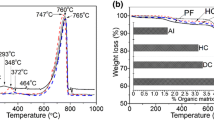Summary
The “cones” and “columns” of the swans egg shell leave behind after decalcification with EDTA an organic (mucoproteid) material in form of a continuous frame work stainable metachromatically with thionine. Without demineralisation or at least etching, thionine proves ineffectual in ground sections or breaking edges of the shell. In ground sections the light microscope demonstrates nothing of the organic material: it was inclosed during the crystal growth in submicroscopical lattice gaps of the calcite individuals. The organic material is chiefly accumulated in the outer and inner surfaces of the crystals. In the “cones” the organic frame work is developed radially as the “loculi” of the “wedges” and concentrically layered corresponding with the globular inclusions, concentrated in the circumference of each. In the “inner columns” the organic material follows to the rhomb pattern. The “outer columns” after decalcification only leave behind a thin lateral organic sheath.
Zusammenfassung
„Kegel“ und „Säulen“ der Schwanen-Eischale hinterlassen am Querschliff nach Entkalkung mit EDTA organisches (mucoproteides) Material als ein zusammenhängendes Gerüst, das sich mit Thionin metachromatisch färbt; ohne Demineralisierung oder wenigstens Anätzung bleibt Thionin an Schliffen und Bruchkanten der Schale wirkungslos. Das Lichtmikroskop zeigt an Schliffen nichts von dem organischen Material, es wurde während des Kristallwachstums fein zerteilt in Gitterlücken des Schalencalcits eingeschlossen. Es findet sich am stärksten angehäuft an den äuβeren und inneren Oberflächen der Kristall-individuen. In den „Kegeln“ ist das Gerüst radial ausgebildet als die „Loculi“ der Keile, und konzentrisch geschichtet, entsprechend den Lagen der Globularinklusionen, um deren jede herum Verdichtung der organischen Substanz statthat. In den „inneren Säulen“ folgt das organische Gerüst dem Rhombenmuster; die „äuβeren Säulen“ sind arm an organischer Substanz, hier verbleibt nach der Entkalkung eine dünne laterale Oberflächenschicht.
Similar content being viewed by others
Literatur
Heyn, A. N. J.: The crystalline structure of calcium carbonate in the avian egg shell. J. Ultrastruct. Res. 8, 176–188 (1963a).
- The calcification of the avian egg shell. Ann. N. Y. Acad. Sci. 1963b, 246–250.
Kelly, A.: Beiträge zur mineralogischen Kenntnis der Kalkausscheidungen im Tierreich. Jena. Z. Med. Naturw. 35, 429–493 (1901).
Schmidt, W. J.: Liegt der Eischalenkalk der Vögel als submikroskopische Kristallite vor? Z. Zellforsch. 57, 848–880 (1962).
—: Über die Struktur einiger abnormer Vogel-Eischalen nebst Bemerkungen zu neueren Auffassungen betreffend Bau und Bildung der Kalkschale. Z. Morph. u. Ökol. Tiere 53, 311–361 (1964a).
—: Das „Fischgrätenmuster“ auf dem Querschliff der kalkigen Eischale von Vögeln. Z. Zellforsch. 62, 53–60 (1964b).
—: Die Deckschicht auf der Eischale von Cygnus olor. Zool. Anz. 172, 431–436 (1964b).
—: Bemerkungen zur leichten Löslichkeit der Calcosphäriten-Zentren in der Vogel-Eischale. Z. Zellforsch. 64, 726–732 (1964d).
—: Die Eisosphäriten (Basalkalotten) der Schwanen-Eischale. Z. Zellforsch. 67, 151–164 (1965a).
—: Das organische Fachwerk in „Kegeln“ und „Kalotten“ der Vogel-Eischale. Z. Zellforsch. 68, 194–204 (1965b).
—: Morphologie der Kalkresorption an der ausgebrüteten Vogel-Eischale. Z. Zellforsch. 68, 874–892 (1965c).
—: Einfache Verfahren zur Darstellung des Mammillenreliefs von Vogel-Eischalen. Z. wiss. Mikr. 67, 114–121 (1966a).
—: Thioninfärbung und Phasenkontrastbild der entkalkten Vogel-Eischale. Z. wiss. Mikr. 67, 149–154 (1966b).
—: Das Verwachsen der Calcosphäriten bei der Schalenbildung des Vogeleies. Z. Morph. u. Ökol. Tiere 56, 252–258 (1966c).
—: Das Rhomben- und Blockmuster im Eischalenkalk von Cygnus olor. Z. Zellforsch. 72, 475–486 (1966d).
Simons, P. C. M., and G. Wiertz: Notes on the structure of membranes and shell in the hen's egg. An electron microscopical study. Z. Zellforsch. 59, 555–567 (1963).
Terepka, A. R.: Structure and calcification in avian egg shell. Exp. Cell Res. 30, 171–182 (1963).
Tyler, C.: Wilhelm von Nathusius 1821–1899. On Avian Egg Shell. Translated and edited version of his work. The University Reading 1964a.
—: A study of the egg shells of the Anatidae. Proc. zool. Soc. Lond. 142, 547–583 (1964b).
—, and F. H. Geake: The testing of methods for cracking egg shells, based on paired readings from individual eggs and the measurement of some effects of various treatments. Brit. Poultry Sci. 5, 19–28 (1964).
Author information
Authors and Affiliations
Rights and permissions
About this article
Cite this article
Schmidt, W.J. Das organische Gerüstwerk der Kalkschale des Schwanen-Eies. Zeitschrift für Zellforschung 73, 475–487 (1966). https://doi.org/10.1007/BF00347076
Received:
Issue Date:
DOI: https://doi.org/10.1007/BF00347076




